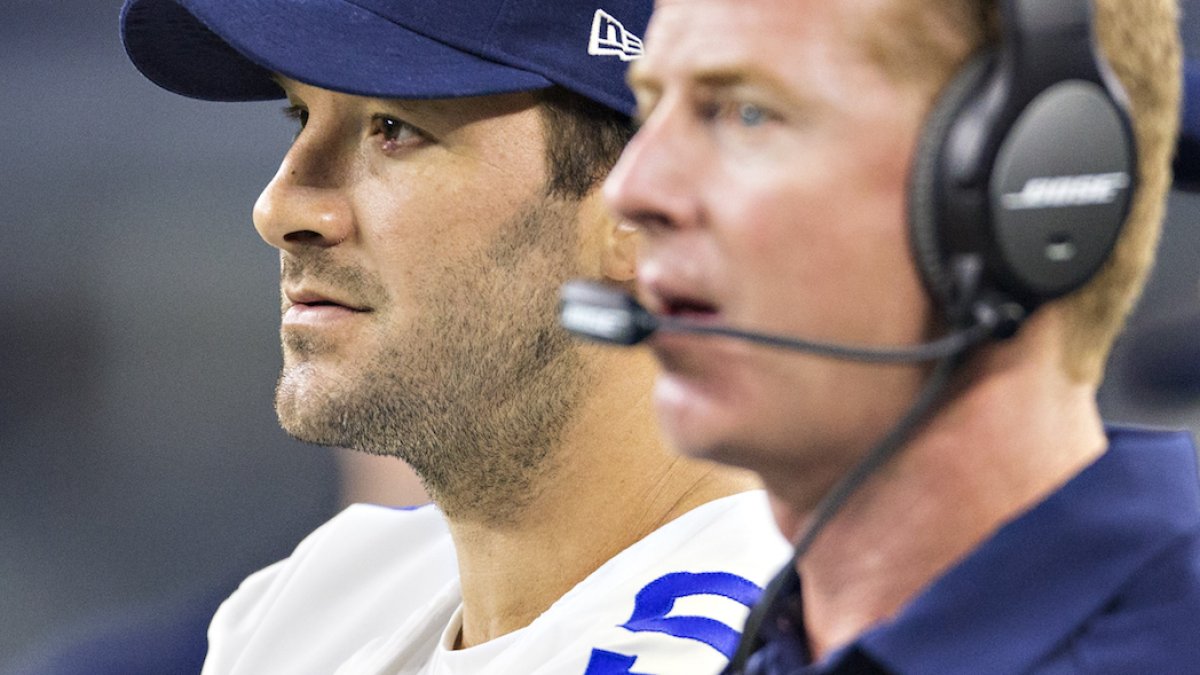Editor’s note: Every weekday in “Daily Focus,” PFF analysts take the latest NFL news and translate what it really means for each team involved.
Cowboys QB Tony Romo has said that last year was an “anomaly” and, from a performance standpoint, at least, he’s absolutely correct. We’ll come to the injury connotation of that statement later, but for now, let’s look at how he’s played when on the field.
From 2010 to 2014, Romo was actually remarkably consistent on a season-to-season basis, as the chart below shows.

In essence, the above grading shows that, from 2010 to 2014, he’s been at the top of the middle-third of quarterbacks—not as bad as his detractors would have you believe, but rarely has he played at a “top-10” level, either. He’s been the alluring balance of a high base with the obvious talent to become elite, but never the production to warrant that label.
Due to injury, he played in only four games last year, and he really was well below his best, particularly in his final 34 snaps against the Panthers on Thanksgiving when, even with a clean pocket, his QB rating was an appalling 23.2.
He never looked like his usual self all year, and injury was the likely cause, so maybe that’s the anomaly he’s referring to.
In the period above, he’s missed 24 of 96 possible contests (25 percent), with exactly half of those coming in 2015 and the majority of the rest in a single year (2010). Is that an anomaly? I guess it depends which side of the debate you’d like to pursue.
As for how next season will go, the evidence suggests Romo can provide 15 games at a level you’d expect from the 10th–ranked QB. My feeling, however, based on how good his offensive line is and his ability to fall back on a superb running game, is a full slate at around the level of the seventh-ranked QB.
Dion Lewis recovering well: Another player coming back from injury and reportedly recovering well is Patriots running back Dion Lewis.
Through the first half of last season, Lewis was New England’s first-choice RB and performed far better than even his most ardent supporters could have hoped; at the end of Week 9, he was our 12th-ranked halfback.

Lewis was very good across the board; of those players listed above, he was the only one to grade “in the green” (above +1.0) in every facet of play—running, receiving and blocking.
This is all very encouraging, but perhaps the most exciting part of Lewis’ performance was how it happened. In short, he was a human highlight machine.
Though Week 9, he broke or avoided more tackles (running and receiving) than any other player, and his rate for this (a tackle avoided every other touch) was more than twice than everyone except three other RBs.
Sam Bradford pulling away in Eagles QB competition: In news that shouldn't really come as a surprise, Sam Bradford is looking like the favorite to start for Philadelphia in Week 1. The only real shock since the draft has been Bradford’s petulant initial reaction to the Eagles taking Carson Wentz at No. 2 overall.
To an outsider, it looks like the ideal situation: Bradford is clearly the No. 1 quarterback in a friendly system with a guy behind him that is about as raw as it’s possible to be. Wentz played at North Dakota State at a level where cornerbacks and coverage schemes were about as far removed from the NFL as Bradford’s response was overboard.

It’s not as if Bradford was struggling last year, either. After a poor first three games—and despite a dysfunctional running game, a mediocre pass-blocking performance, and a group of receivers who couldn’t hang on to passes—he was our eighth-ranked QB through the last 13 games, and 12th overall for the season.
For a QB playing as well as Bradford, the worst case scenario would be to get through the year enhancing his stock and getting another significant deal from a QB-needy team. Make no mistake, playing simply as well as he did last year, Bradford would be good enough to take a team like Denver to Super Bowl glory.
Jordan Matthews staying in the slot could mean 200 less snaps for Eagles WR: When Doug Pederson came on board as the new head coach in Philadelphia, one of his initial ideas was to move Jordan Matthews to a more hybrid inside/outside receiver.
Last year, no player had a higher percentage of his passing snaps from the slot than Matthews (92.7 percent), although the fact that he came off the field a lot in less than three-WR packages meant he only played 79 percent of the snaps in total (and therefore Randall Cobb played more slot snaps in overall terms (549 versus 533).

However, from all reports, it seems that plan hasn’t worked out as well as hoped to date and, and unless things change in training camp, Matthews' role in 2016 will look very similar to that of 2015.
Now, if Pederson runs the same balance of packages he did in Kansas City, and Matthews plays in the same ratio as last year, that could result in a significant reduction of snaps for Matthews—by my calculation, about 200.


 © 2024 PFF - all rights reserved.
© 2024 PFF - all rights reserved.